 Koninklijke Marine Frigates: Frigate 75 Programme, Built 1975-83.
Koninklijke Marine Frigates: Frigate 75 Programme, Built 1975-83.HNLMS Kortenaer, Egbert Bartholomeusz, Callenburgh, Van Kinsbergen, Banckert, Piet Hein, Peter Florisz, Witte de With, Abraham Crijnssen, Philips van Almonde, Bloys van Treslong, Jan van Brakel, Pieter Florisz (F807 to F826)
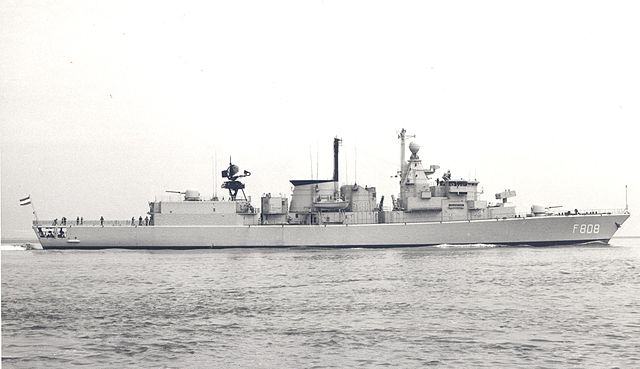
The Euro “standard frigates”.
The Kortenaer class were anti-submarine frigates of the Royal Netherlands Navy capitalizing on the innovation brought by the previous decade Tromp class. They featured a COGOG, had missile and modern sensors, and were highly automated. Ten were built by De Schelde in Vlissingen, two by Wilton-Fijenoord in Schiedam until 1982. They took their fair share of NATO’s ASW patrols between the north sea and Atlantic. However, after the end of the cold war they became redundant and started to be sold abroad. Eventually, all but two were sold to Greece, plus the Peter Florisz and Witte de With that were completed for Greece as well. Two more were sold to UAE. They are now all replaced by the new Jacob van Heemskerck-class frigates. One had been converted into the superyacht Yas, which is a rare case of civilian reconversion. #netherlands #coldwar #frigates #kortenaer #elli
Development
The Kortenaer class were anti-submarine warfare (ASW) frigates replacing the 1950s Holland and Friesland classes, which were classic destroyers under the denomination of “submarine hunters”. The previous Tromp class frigates arlready showed what was possible in terms of missile and radar, propulsion and automation, leading the way. But they were pretty expensive and only two were made. To provide NATO its ASW contribution, the Dutch planning committee wanted a cheaper, smaller class of frigates that would integrated as many NATO compatible systems as any other NATO frigate class, in order to make these more appealing on the export market withing Europe as well. The ambitious programm was offered to other navies such as the British Royal Navy. The latter rejected it however, and instead the Dutch designed a standard platform (“Standard design”) that would become indeed a European standard later. These frigates were designed to assume both ASW and anti-aircraft warfare (AAW) variants all withing strict NATO standards.
Design of the class
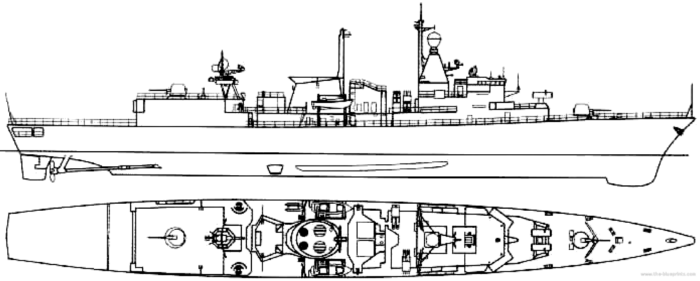
Hull and general design
The hull shape resemble that of the Tromp, but with a continuous deck and prow resembling the French frigates of the time. The transom stern was rounded and there was a single anchor forward in the bow. The Continuous upper and main decks with single rudder and a clipper bow were indeed close to the Duquesne and De Grasse class frigates. They had a reduced length-to-beam ratio for their size. Like the Tromp, but even pushed further froward, they had a higher degree of automation. The engine room complement was much reduced and operated the complex powerplant through a push-button central operation room. There was redundancy in control also, as the machinery could be remotelly controll as well if needed from the central operations room, which already gatherd all sensory data and manage the armament and navigation.
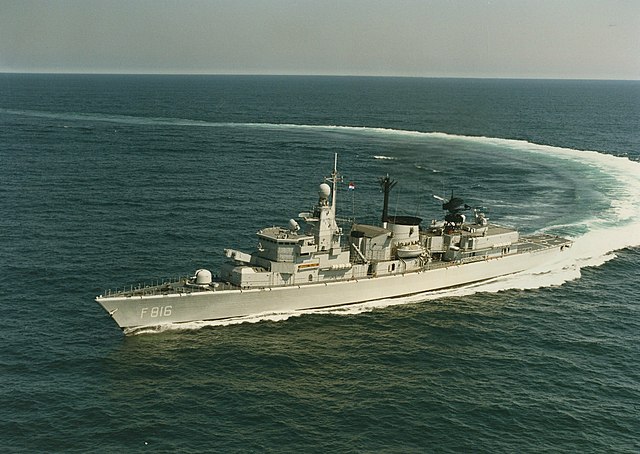
The Kortenaer class were not small vessels and with 130.5 metres (428 ft 2 in) long overall for 14.6 m (47 ft 11 in)in beam (1/95 ratio)) plus a draught of 4.3 m (14 ft 1 in) up to 6.2 m (20 ft 4 in) mean draft under the propeller, they displacement of 3,100 tonnes (3,050 long tons) standard, and 3,690 t (3,630 long tons) fully loaded, but this ranged widely due to many changeds in radars and armament, making theem easy to upgrade and modular. High automation reduced their complement to just 176 officers and sailors, 196 when acting as flagships. This was half the crew of a Tromp class, already automated. The hull was subdivided between 15 watertight bulkheads but there was not particular protection anywhere. It all was active, resting on EW systems and chaffs.
There was a large, roomy hangar aft to operate tw helicopters plus a generous helipad, occupying up to 1/3 of the hull aft, the single maain squared funnel was in the center, with exhausts providing thermal reduction. There was a “tree-like” aft sensory mast close to the funnel, and a foremast anchored to the pyramidal main radar antenna atop the bridge, with the main armament mounted forward, both being mostly AAW, between a, OTO Melara deck gun and Sea Sparrow SAM launcher superfiring. The three-faceted bridge was tall and entirely enclosed.
Powerplant
Thes frigates received like the Tromp class, a combined gas or gas (COGOG) powerplant, relying on two Rolls-Royce Tyne RM1C gas turbines rated each for 3,700 kilowatts (4,900 shp), coupled with Rolls-Royce Olympus TM3B gas turbines again rated each for 19,200 kW (25,700 shp). The first low pressure for cruising, the second high pressure for speed, and both could operate in concert, leaving agreat deal of flexibility and fast operation unlike previous steam turbines. They were coonnected to LIPS (controllable pitch propellers) and ansured a top speed of 30 knots (56 km/h; 35 mph) with a cruising speed of 20 knots (37 km/h; 23 mph).
Range was 4,700 nautical miles (8,700 km; 5,400 mi) at 16 knots (30 km/h; 18 mph) on a single Tyne turbine. In case these were all shut down or disabled, they still could operate basic onboard systems and all armament, by the electricity provided, via two generator, from four SEMT-Pielstick PA4 750 kW diesels. This redundancy in design even called for two auxiliary boilers and evaporators to provide a third backup for onboard energy. These occupied four compartments, one for the LP, one for the HP gas turbines, one for the diesels, one for the steam plant. In order from the prow, auxiliaries, Olympus turbines, Tyne turbines and reduction gear, auxiliaries again, widely separated. For extra stability as they were intenbded to operate helicopters, the Kortenaer class had two Denny–Brown fin stabilizers in addition to classic counterkeels.
Armament
Main Gun: OTO Melara 76/62 Compatto
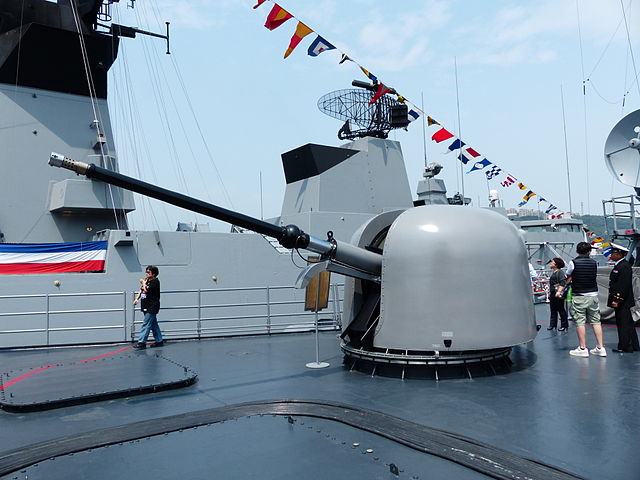
The design originally called for two OTO Melara 76 mm (3 in)/62 calibre naval guns in single mounts each, one forward, one mounted atop the hangar aft. It was done for the first four, but this proved imparctical, and from the fourth ships onwards, this aftmount was replaced by a much lighter Bofors 40 mm (1.6 in)/L70 AA gun.
The OTO Melara 76/62 Compatto 76 mm gun fired a 6 kg (13 lb) shell to 8.6 nmi (15.9 km; 9.9 mi) in range abnd up to 85 degrees elevation. This lightweight, fast firing gun was designed and introduced in 1963 with a rounded turret, fully automated. It was capable of 85 rounds/min and of 16 km rangen but later versions of the super rapido could fire up to 40 km. This gun became standard in Europe as well, one of the best seller of the 1970-80s. Magazine capacity was 80 ready rounds on Compatto gun mount.
⚙ specifications OTO 76/62 Compatto |
|
| Weight | 7.5 tonnes (17,000 lb) |
| Barrel lenght | 62 caliber: 4,724.4 mm (186.00 in) |
| Elevation/Traverse | +85° @35°/s; 360° @60°/s−15° |
| Loading system | Full auto |
| Muzzle velocity | 915 m/s (3,000 ft/s) |
| Range | HE-PFF 16,000 m |
| Guidance | |
| Crew | Remote controlled |
| Round | 76×636mmR 12.5 kilograms (28 lb)oa/ 6.3 kilograms (14 lb)/ PPlt 2.35 kilograms (5.2 lb) |
| Rate of Fire | 85 rounds/min |
CIWS: SGE-30 Goalkeeper
The aft Bofors were later replaced (in all ships) by a seven-barreled SGE-30 Goalkeeper 30 mm (1.2 in) close-in weapons system (CIWS) capable of a 2 km (1.2 mi) range, usable mostly against incoming missiles. Specs already on the Tromp class frigates.
⚙ specifications Goalkeeper CIWS |
|
| Weight | 9,902 kg (21,830 lb) total, 6,372 kg (14,048 lb) gun alone. |
| Barrel lenght | 3.71 m above deck, total 6.2 m over and under deck. |
| Elevation/Traverse | +85 to −25° (80 degree/s |
| Loading system | Automated 7-barrel feed, 1,190 rds of ammunition above deck |
| Muzzle velocity | 1,109 m/s (MPDS round) |
| Range | 350-1,500/2,000 metres dependent on ammunition |
| Guidance | Radar guided, full auto tracking |
| Crew | Automated, with human oversight |
| Round* | 1.2 in or 30×173mm TP, HEI, MPDS, or FMPDS |
| Rate of Fire | 7-barrel rotary cannon GAU-8/A Avenger, 70 rps/4,200 rpm |
Harpoon Missiles
Two quad launchers for Harpoon anti-ship missiles mounted aft on the bridge, facing both sides at an angle. These were unarmoured canisters. They formed the primary line of defence against ships, with the longest reach of all three weapons systems, 140 km. This was also a brand new weapons system, in service by 1977 and installed in their early years. Block I of course. Each missile was capable of travelling 70 nmi (130 km; 81 mi) at Mach 0.9 carrying a 227 kg (500 lb) warhead.
⚙ specifications RGM-84 Harpoon Block I |
|
| Weight | 1,523 lb (691 kg) including booster |
| Dimensions | 15 ft x 13.5 in (4.6 m x 34 cm), wp 3 ft (0.91 m) |
| Propulsion | Teledyne CAE J402 turbojet/solid propellant booster, 600 lbf (2,700 N) thrust |
| Speed | 537 mph (864 km/h; 240 m/s; Mach 0.71) |
| Range | 75 nmi (139 km) |
| Guidance | Radar altimeter, active radar terminal homing |
| Ceiling | Sea Skimming |
| Payload | HE warhead |
Sea SparrowSAM
These ships had a Mark 29 octuple launcher for the Sea Sparrow missile with 24 missiles in reserve, rloaded vertically. The Sea Sparrow had a range of 8 nmi (15 km; 9.2 mi), Mach 2.5 with a 30 kg (66 lb) warhead. This was a short range AA defence system. It was controlled by a small radar under radome right behind on the superfiring position. The sea sparrow were just entering US service at the time the class was launched, in 1976. It had been developed by Raytheon and General Dynamics. Delivered in two-arm four canister launcher it could deliver all these in a minute and incoming threats, flying to their targets at Mach 4. Shorter range meant shorter delays.
⚙ specifications RIM-7 Sea Sparrow |
|
| Weight | 510 lb (230 kg) |
| Dimensions | 12 ft x 8 in (3.7 m x 20 cm) wp 3 ft 4 in (1.02 m) |
| Propulsion | Hercules MK-58 solid-propellant rocket motor |
| Speed | 4,256 km/h (2,645 mph) |
| Range | |
| Guidance | |
| Range/Ceiling | 10 nmi (19 km) |
| Accuracy | |
| Payload | Annular blast fragmentation warhead, 90 lb (41 kg)* |
*Proximity fuzed, expanding rod, with a 27 ft (8.2 m) kill radius
Torpedo Tubes
The frigates were equipped with two twin-mounted Mk 32 324 mm (13 in) torpedo tubes. They are used to fire the Mk 46 Mod 5 acoustic torpedoes for close range (5.9 nmi; 10.9 km; 6.8 mi) ASW defence, at 40 knots (74 km/h; 46 mph) with a 44 kg (97 lb) warhead.
Sensors
![]()
Radars
ZW-06 Radar: Surface search and navigation radar, X-band, 8 600-9 500 MHz, 24 rpm, instrumented range 22 km
LW-08 Radar: High-power, coherent, D-band air warning and surface search radar for medium/long range surveillance.
WM-25 DCS Radar: Small dome like fire control radar for the Sea Sparrow missiles
STIR-18 radar: STIR (Signal Tracking and Illumination Radar) medium/long range fire-control radar from Thales. tracking/missile illumination.
Sonars
SQS-505 Sonar: Hull mounted and VDS, medium frequency active / passive search sonar, used also by the RCN
SQS-509 (PHS-36) sonar On F823-826. Lower-frequency version of the AN/SQS-505, power output is also increased.
Active Protection
Sphinx ECM suite, 2x Corvus decoy RL, SEWACO II CCS
The Kortenaer class was initially equipped with a Knebworth/Corvus rocket-launched chaff system, replaced by SRBOC six-tubed chaff launchers.[7] They sported an ESM/ECM Ramses jammer and a SEWACO II action data system. They utilised LW 08 air search radar operating on the D band, ZW 06 surface search radar operating on the I band and STIR and WM 25 fire control radars operating on the I/J bands. For ASW purposes, the frigates had bow-mounted SQS-505, SQS-509 sonar or SQR-19 TACTASS towed sonar. The Kortenaer class had a flight deck and hangar at the stern of the ship that was initially capable of operating up to two Westland SH-14B Lynx helicopters, but normally carried only one during peacetime operations.[4]
Air Group
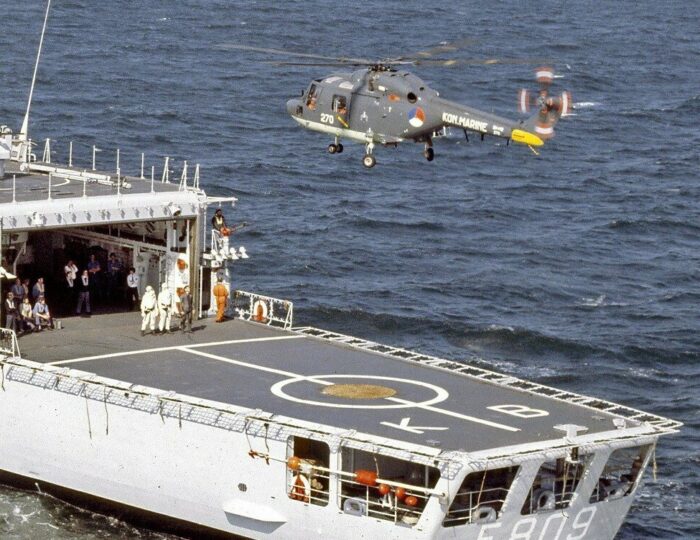
Both operated two SH-14D Sea Lynx. The Royal Netherlands Navy’s as part of its Naval Aviation Service operated 24 Lynx over 36 years. They entering service at the same time as the Tromp class in 1976 phased out in 2012 (replaced by the EH-101). They were used for SAR, transport and ASW/ASUW, special forces tasks. They flew from the aft helideck of the Tromp class and had a hangar just large enough for maintenance. In 1993, this Lynx fleet was upgraded to the common Lynx SH-14D standard. One was lost in 1999 due to a rotor-head issue. All were temporarily grounded until retrofitted with new titanium rotor-heads.
⚙ specifications |
|
| Displacement | 3,100 t standard, 3,690 t full load |
| Dimensions | 130.5 x 14.6 x 4.3m (428 ft 2 in x 47 ft 11 in x 14 ft 1 in) |
| Propulsion | 2 shafts COGOG: 2× RR Tyne RM1C GST, 2× RR Olympus TM3B GST 61,200 hp |
| Speed | 30 knots max, 20 knots cruise |
| Range | 4,700 nm (8,700 km; 5,400 mi) at 16 knots |
| Armament | 1× OTO-Melara 76 mm/62, 1× Bofors 40 mm, 2×2 Mk46 TTs, 2×4 RGM-84 Harpoon, 1× 8 Sea Sparrow |
| Sensors | ZW-06, LW-08, WM-25, STIR-18 radars, SQS-505 sonar |
| Protection | Sphinx ECM suite, 2x Corvus/Mk 36 SRBOC decoy RL, SEWACO II CCS |
| Air Group | 2× Westland SH-14D Sea Lynx helicopters |
| Crew | 176–196 |
Construction & Modernization
The first batch of four was ordered on 31 August 1974, followed by a second batch of four on 28 November 1974 and third batch of four on 29 December 1976. This was the most ambitiouys naval construction in the Netherlands so far. The first eight came from Royal Schelde. The 9th, 10th from Wilton-Fijenoord, final two from Royal Schelde again. Contract was signed on 15 September 1980 with Greece to sell two hulls under construction (plus an option for one more), obtained by 7 June 1981. The Kortenaer-class were intended to patrol areas of the Atlantic Ocean until the 1990s, and after the end of the cold war, attention shifted to the Mediterranean Sea and red sea. With NATO and/or the UN, they took part Yugoslav Wars, Strait of Hormuz and Persian Gulf operation, Gulf War. In 1993, Bloys van Treslong took part in the blockade of Haiti. In 2001, Philips van Almonde took part in Operation Enduring Freedom. Budget cuts for their early retirement. All but two were sold to Greece after 15 years of service on average, two to Saudi Arabia, which converted them into superyachts a few years later (see below).
1982, Kortenaer: – 1 x 1 – 76/62; + 1 x 1 – 40/70 Bofors 350
1984, Callenburgh: – 1 x 1 – 76/62; + 1 x 7 – 30/77 Goalkeeper, Goalkeeper radar
1986-early 1990s, Kortenaer, Van Kinsbergen, Banckert, Piet Hein, Abraham Crijnssen, Philips van Almonde, Bloys van Treslong, Jan van Brakel, Pieter Florisz: – 1 x 1 – 40/70; + 1 x 7 – 30/77 Goalkeeper, Goalkeeper radar
1986-early 1990s, all survived: + Ramses ECM suite, SLQ-25A Nixie torpedo decoy
1987-early 1990s, Kortenaer, Callenburgh, Van Kinsbergen, Piet Hein: – 2x Corvus decoy RL; + 2x Mk 36 SRBOC decoy RL
1989-1990, Jan van Brakel, Pieter Florisz: – 2 helicoipters; + SQR-18A sonar
1991, Pieter Florisz: + 2 x 1 – 20/70 Mk 10, 2 x 1 – 12.7/90
Exports and new customers
On 9 November 1992, Greece signed an agreement to acquire the rest of the class, to add to the two ships already completed for its navy (Elli class). There were three in the first batch: Banckert, Callenburgh and Van Kinsbergen. Next were Kortenaer, Peter Florisz, Jan van Brakel, Philips van Almonde and Bloys van Treslong. The remaining two went to the United Arab Emirates, contract being signed on 2 April 1996 after a refit at Royal Schelde.
 Elli class
Elli class
Elli, Limnos, Kountourioti, Adrias, Navarinon, Aigaion, Themistokles, Nikiforos Fokas, Kanaris, Bouboulina
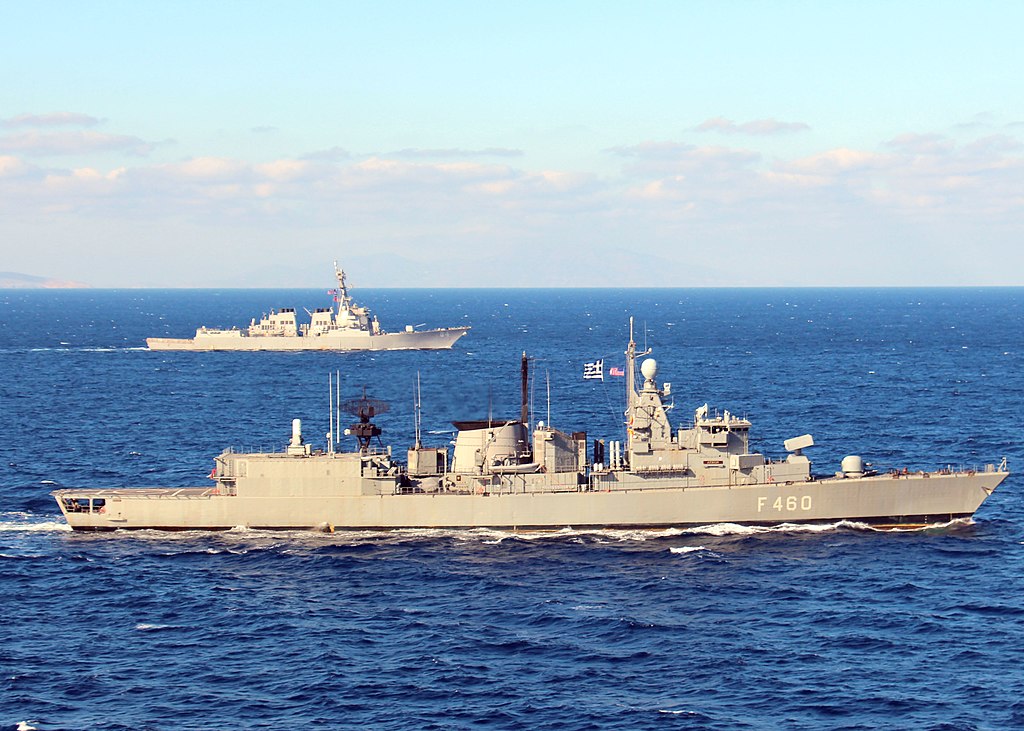
Elli took part in the Persian Gulf War from 1990–91, enforcing the UN resolution on Iraq in the neighborhood of the Red Sea. Limnos took part also in Operation Desert Storm and Operation Desert Shield in 1990 and 1991. She guarded the 2004 Summer Olympics in Athens (Operation Ifitos) and was in Operation Ocean Shield, NATO anti-piracy 2009 operation. In 2011 she took part in Operation Unified Protector (Libyan Civil War) and Operation Active Endeavour. However in August 2020 she was involved in a collision with TCG Kemal Reis. Both are still active, as the rest of the class.
 Al Emirat class
Al Emirat class
Al Emirat, Abu Dhabi
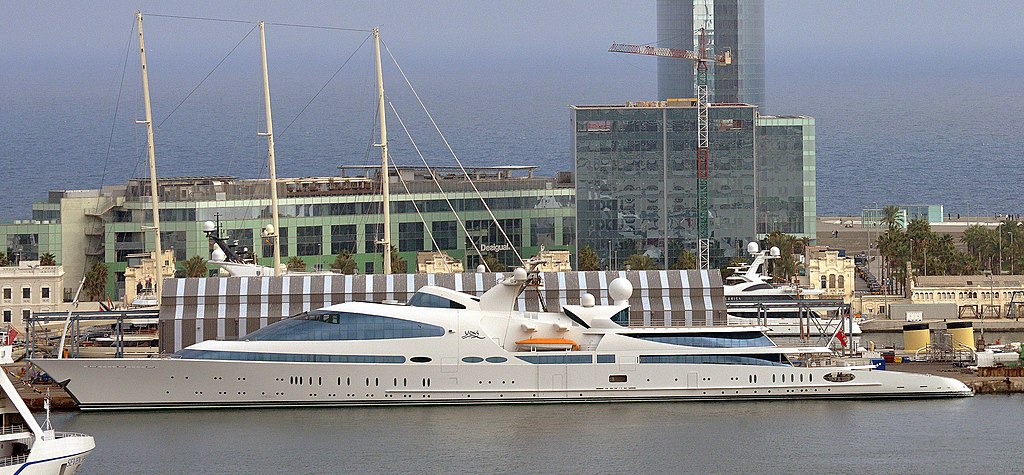
The former Piet Hein and Abraham Crijnssen were sold in 1997-98 under these new names; but they saw limited service. The first became the superyacht Yas, one of the largest conversion ever done and only one known of a former frigate. The other followed the same fate, decommissioned in 2008 and converted into the superyacht SWIFT 135 in the netherlands. Name and fate not known.
 Kortenaer F807
Kortenaer F807
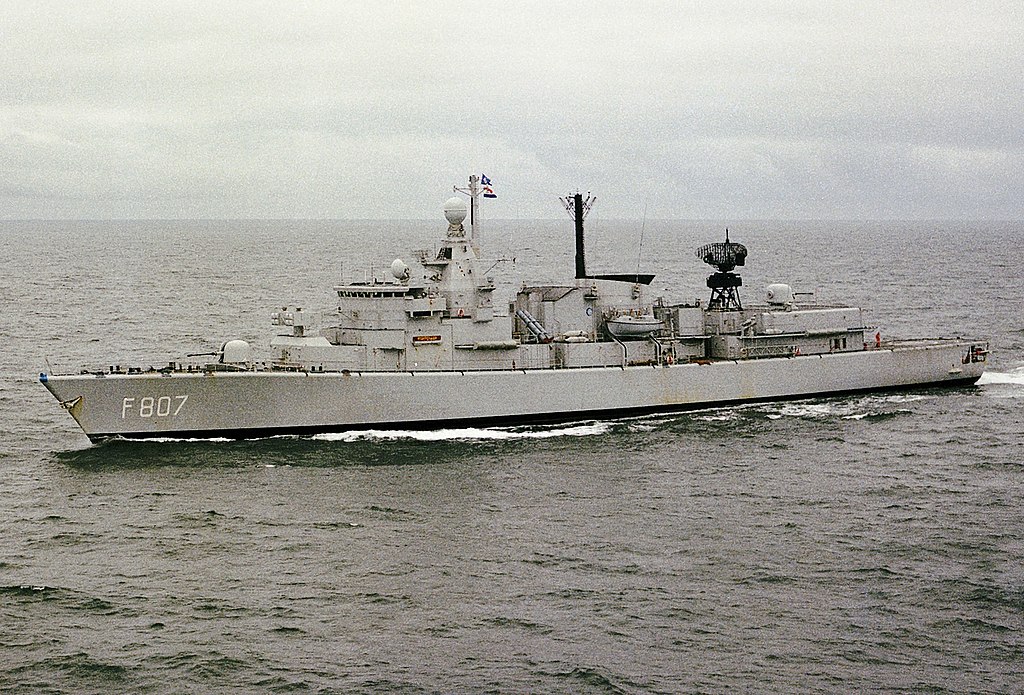
Built at KM De Schelde, in Vlissingen, laid down on 8.4.1975, launched 18.12.1976, completed 26.10.1978. On 12 March 1979 she and the Tromp plus the destroyer Drenthe sailed with the tanker Poolsterto the Far East to show the flag. In 1988 Kortenaer and the frigates Jan van Brakel and Witte de With and the tanker Zuiderkruis mae anotehr cruise to the far east and Australia to show the flag and training. In June 1994 Kortenaer ship participated in BALTOPS 94. On 15 February 1996 Kortenaer was decommissioned and in June or December 1997 she was sold to the Hellenic Navy, renamed Kountouriotis.
 Callenburgh F808
Callenburgh F808
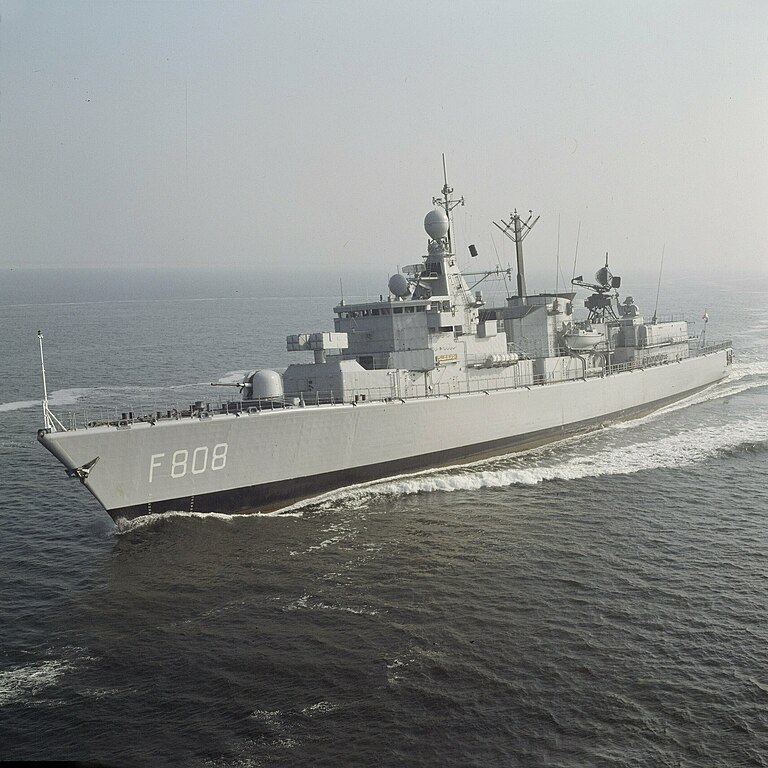
She was also from De Schelde, laid down on 2.9.1975, launched on 26.3.1977, completed on 26.7.1979. Callenburgh, De Ruyter, Jan van Brakel, Van Kinsbergen and the tanker Poolster left Den Helder on 13 January 1986 for the Far East to show the flag and promote Dutch trade, back home on 19 June. On 8 February 1982, she sailed with Tromp, Van Speijk, Piet Hein, the destroyer Overijssel and tanker Zuiderkruis for a cruise to the United States to celebrate 200 years of diplomatic relations starting with New York, former Neeu Amsterdam. They were back to Den Helder on 19 May 1982. She was sold to Greece in March 1994 as Adrias.
 Van Kinsbergen F809
Van Kinsbergen F809
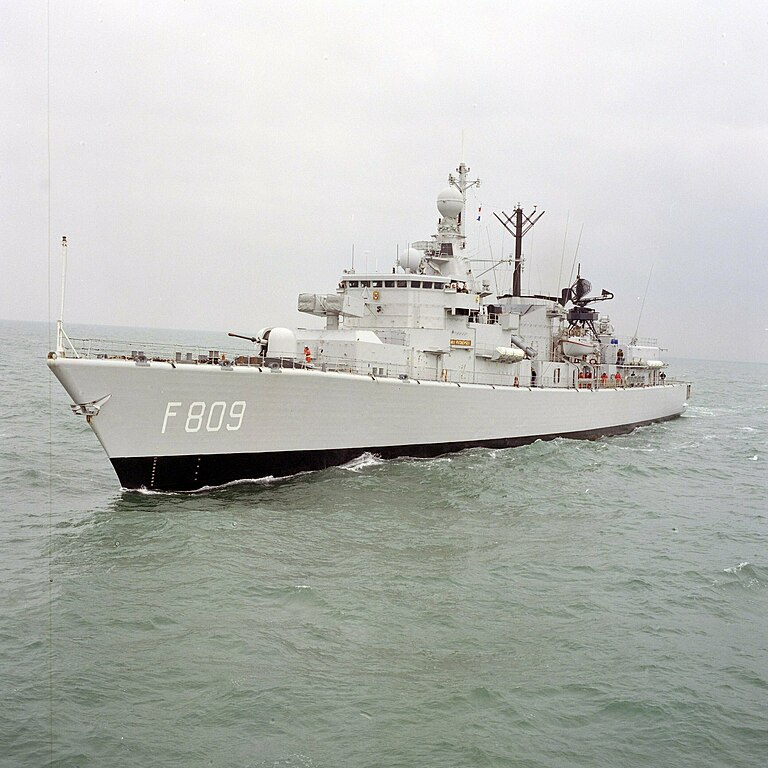
Van Kinsbergen was also from De Schelde, laid down 2.9.1975, launched 16.4.1977 and completed on 24.4.1980
Van Kinsbergen and De Ruyter, Callenburgh, Jan van Brakel and the tanker Poolster led Den Helder on 13 January 1986 for the Far East to show the flag, promote Dutch trade and back on 19 June. Nothing to note afterwards. In March 1995 she was transferred to the Hellenic Navy and renamed Navarinon.
 Banckert F810
Banckert F810
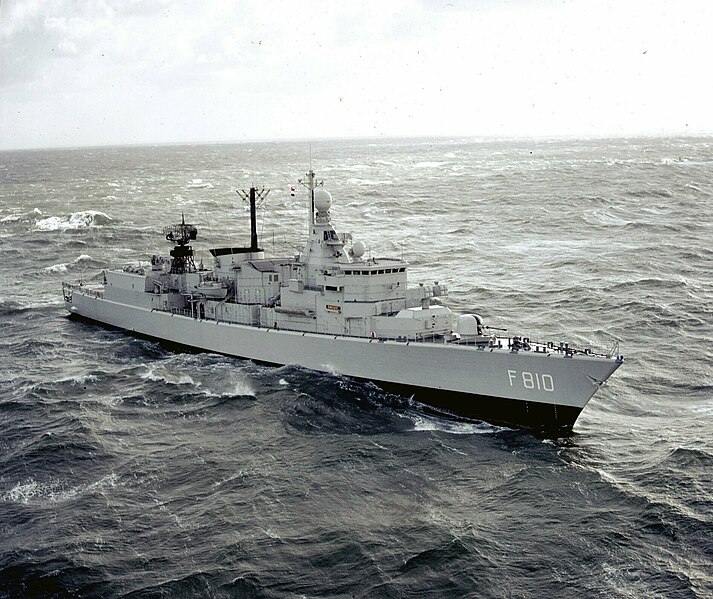
Banckert was also from De Schelde, laid down on 25.2.1976, launched on 30.9.1978 and completed on 29.10.1980. She was added to STANAVFORLANT on 7 January 1983 and met the assembled fleet on 20 January in Plymouth. She left on 6 November as station ship from 17 November 1989 until 19 May 1990. She was sold to Greece in May 1993 as Aigaion.
 Piet Hein F811
Piet Hein F811
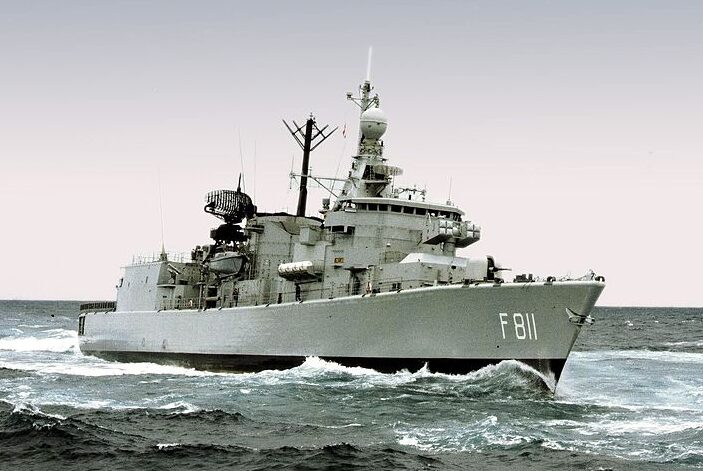
Piet Hein was also from De Schelde, laid down on 28.4.1977, launched on 3.6.1978 and completed on 14.4.1981. On 8 February 1982, she teamed up with the frigates Tromp, Callenburgh, Van Speijk, and the destroyer Overijssel as well as the Zuiderkruis, from Den Helder to the United States and 200 years diplomatic relations. She was back at Den Helder on 19 May 1982. She was stricken in June 1998, sold to UAE as “Al Emirat”.
 Pieter Florisz F812
Pieter Florisz F812

P. Florisz was also from De Schelde, laid down on 2.7.1977, launched 15.12.1979 and completed on 10.10.1981. At that stahe a new naval plan was aimed at reducing the fleet’s side. She was then sold after negociation, still incomplete at berh, to Greece and renamed Elli. She was the lead ship of a class that would comprise all but two ships of the class.
 Witte de With F813
Witte de With F813
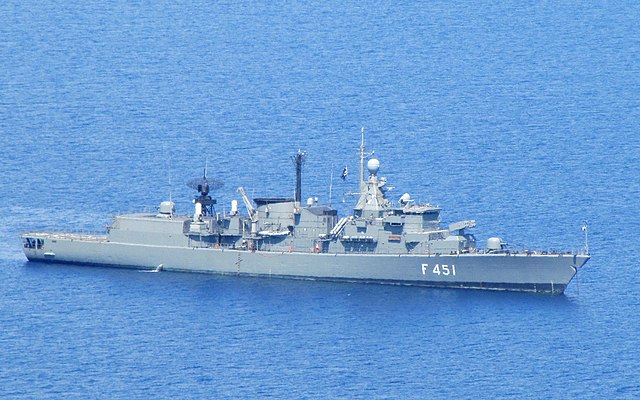
De Witte was also from De Schelde, laid down on 13.6.1978, launched 27.10.1979 and completed on 18.9.1982. She was sold incomplete to Greece as Limnos, same story as above. She was thus never in service with the Netherlands Navy under this name.
 Abraham Crijnssen F816
Abraham Crijnssen F816
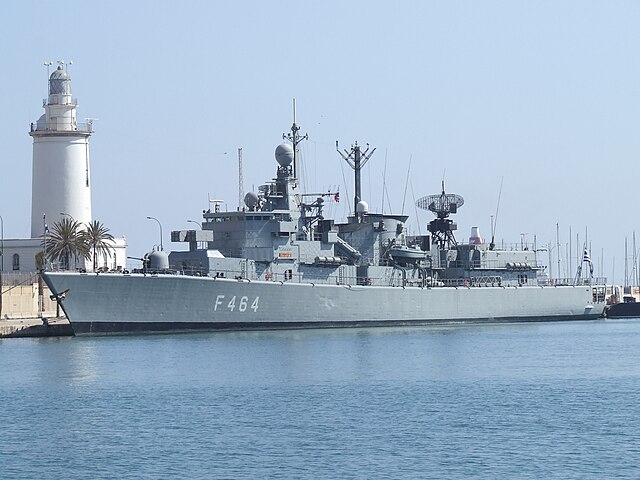
Crijnssen was also from De Schelde, laid down on 25.10.1978, launched on 16.5.1981 and completed on 6.1.1983. Abraham Crijnssen escort the British aircraft carrier HMS Ark Royal in UNPROFOR, Adriatic, by May 1993 in Relation of the ex-Yugoslavian conflict. In June 1994 she took part in BALTOPS with other navies in the Baltic. In 1997 she was decommissioned and was sold to the United Arab Emirates Navy. Recommissioned on 31 October 1997 she was renamed “Abu Dhabi”, and served until decommissioned in 2008 to be reconverted into a yacht.
 Philips van Almonde F823
Philips van Almonde F823
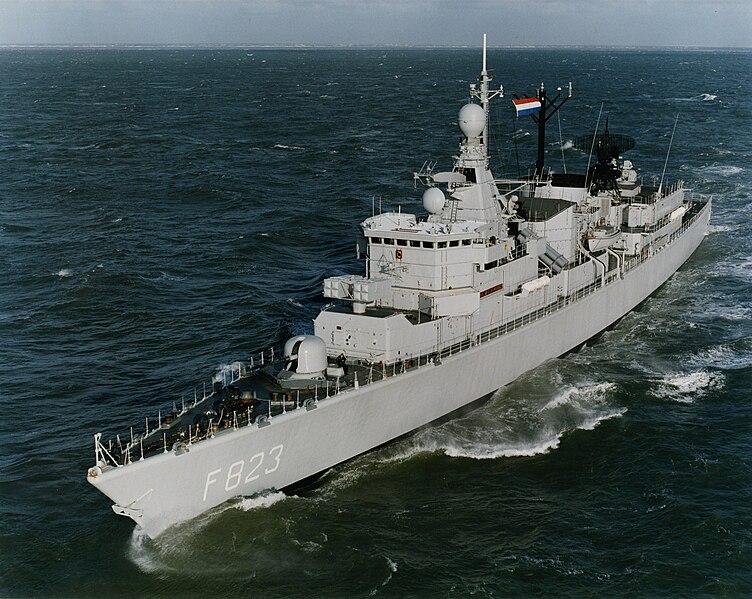
Unlike the rest of the class, Philips van Almonde was the only one with van Treslong to be built at Wilton-Fijenoord, Schiedam, laid down on 1.10.1977, launched on 11.8.1979 and completed in 2.12.1981. She, Jacob van Heemskerck and tanker Zuiderkruis were deployed during the Gulf War and replaced the previous group compose of Witte de With and Pieter Florisz on 4 and 5 December 1990. From 2 July to 15 December 1984 she was a station ship for STANAVFORLANT. In 2001 after the 11 September attacks she took part in Operation Enduring Freedom. In October 2002 she was decommissioned and sold to the Hellenic Navy Themistokles.
 Bloys van Treslong F824
Bloys van Treslong F824
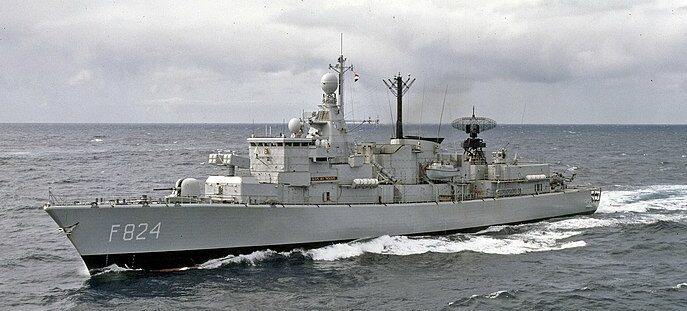
Bloys van Treslong was the second frigate of the class built at Wilton-Fijenoord, Schiedam laid down on 5.5.1978, launched on 15.11.1980 and completed on 25.11.1982. In 1993, she served as station ship in the West Indies. She headed for Haiti in support of the UN peace mission Support Democracy. In 1996, she sailed to Norway with the frigates Jacob van Heemskerck, Willem van der Zaan, Tromp and tanker Amsterdam, also taking part in far north exercises with orther NATO forces. She was sold to Greece by December 2004 as Nikiforos Fokas.
 Jan van Brakel F825
Jan van Brakel F825
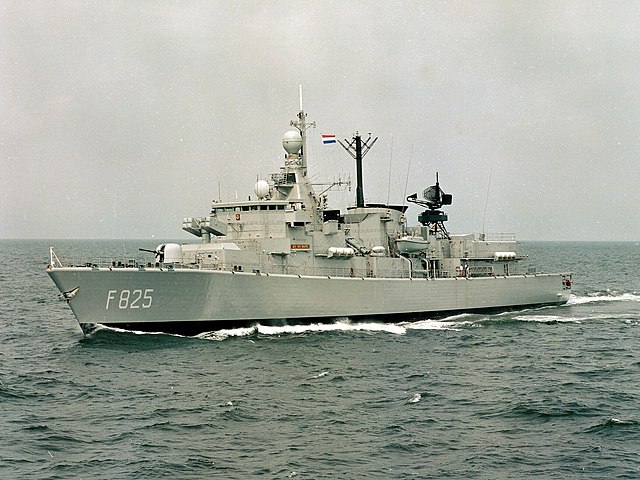
Jan van Brakel was from De Schelde, laid down on 16.11.1979, launched on 16.5.1981 and commissoned on 14.4.1983. In 1988 she sailed for the Far East and Australia to show the flag and training, with Kortenaer and Witte de With, and the tanker Zuiderkruis. From March until October 1993 she was in the Adriatic Sea, for NATO and UN operations in ex-Yugoslavia. She was stricken on 12 October 2001, and sold to Greece as Kanaris.
 Pieter Florisz (ex-Willem van der Zaan) F826
Pieter Florisz (ex-Willem van der Zaan) F826

Pieter Florisz was the last of these frigates built at KM De Schelde, Vlissingen, laid down on 15.1.1980, launched on 8.5.1982 and completed on 1.10.1983. Pieter Florisz and Witte de With took part together in the Gulf War and were replaced by Philips van Almonde, Jacob van Heemskerck and the tanker Zuiderkruis, on 4 and 5 December 1990. In June 1994 she took part in BALTOPS 94 naval exercise for NATO. She was retired from service and sold to Greece in June 2001 as Bouboulina.
Read More/Src
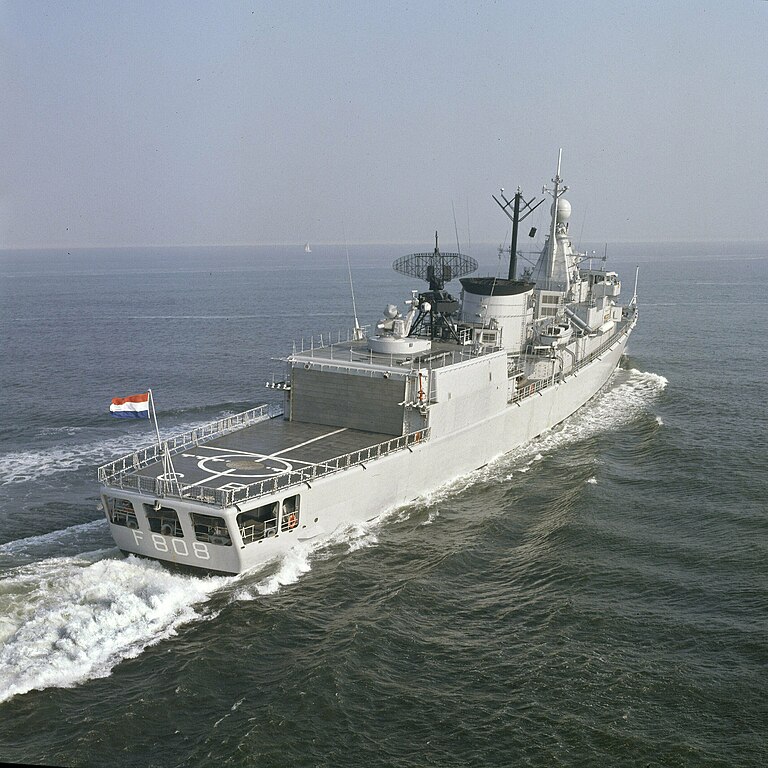
Books
Baker, A. D., ed. (1998). The Naval Institute Guide to Combat Fleets of the World 1998–1999. NIP
Friedman, Norman (1997). The Naval Institute Guide to World Naval Weapon Systems 1997–1998. NIP
Gardiner, Robert; Chumbley, Stephen, eds. (1995). Conway’s All The World’s Fighting Ships 1947–1995. NIP
Moore, John, ed. (1979). Jane’s Fighting Ships 1979–80. London: Jane’s Yearbooks.
Saunders, Stephen, ed. (2002). Jane’s Fighting Ships 2002–2003. Coulsdon, UK: Jane’s Information Group.
Links
navypedia.org/
seaforces.org/
worldnavalships.com/
navalanalyses.com/
armedforces.co.uk/
reddit.com/r/
globalsecurity.org/military
en.wikipedia.org
charterworld.com/index.html yacht
Karel+Doorman+class

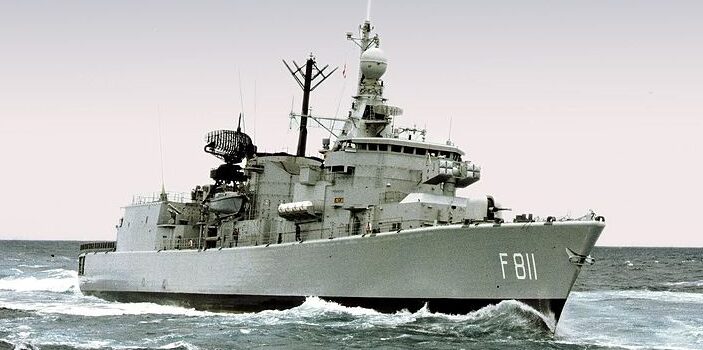
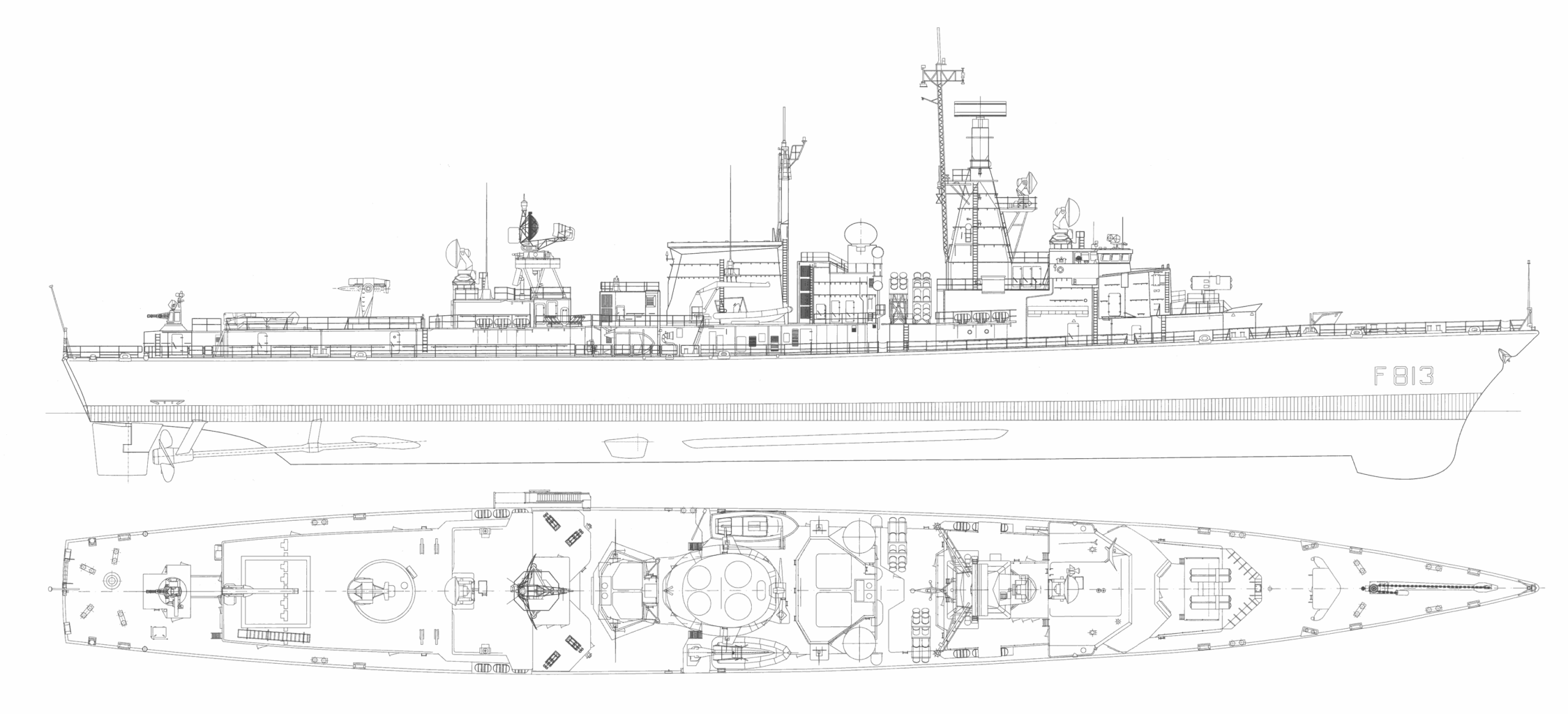
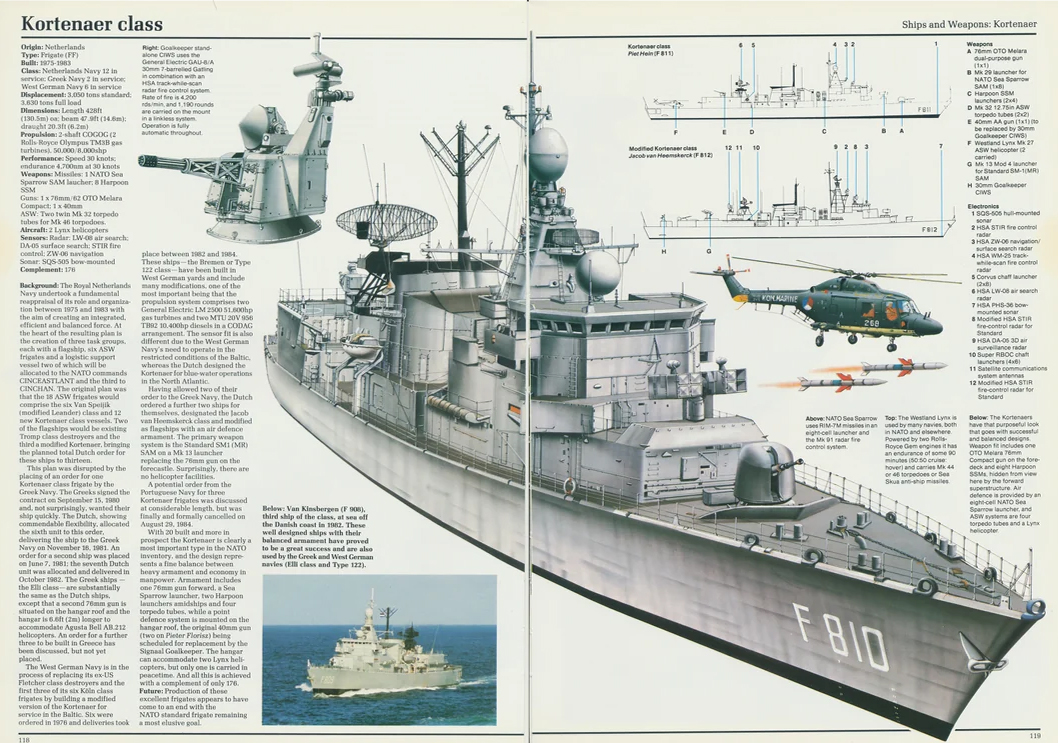
 Latest Facebook Entry -
Latest Facebook Entry -  X(Tweeter) Naval Encyclopedia's deck archive
X(Tweeter) Naval Encyclopedia's deck archive Instagram (@navalencyc)
Instagram (@navalencyc)





 French Navy
French Navy Royal Navy
Royal Navy Russian Navy
Russian Navy Armada Espanola
Armada Espanola Austrian Navy
Austrian Navy K.u.K. Kriegsmarine
K.u.K. Kriegsmarine Dansk Marine
Dansk Marine Nautiko Hellenon
Nautiko Hellenon Koninklije Marine 1870
Koninklije Marine 1870 Marinha do Brasil
Marinha do Brasil Osmanlı Donanması
Osmanlı Donanması Marina Do Peru
Marina Do Peru Marinha do Portugal
Marinha do Portugal Regia Marina 1870
Regia Marina 1870 Nihhon Kaigun 1870
Nihhon Kaigun 1870 Preußische Marine 1870
Preußische Marine 1870 Russkiy Flot 1870
Russkiy Flot 1870 Svenska marinen
Svenska marinen Søværnet
Søværnet Union Navy
Union Navy Confederate Navy
Confederate Navy Armada de Argentina
Armada de Argentina Imperial Chinese Navy
Imperial Chinese Navy Marinha do Portugal
Marinha do Portugal Mexico
Mexico Kaiserliche Marine
Kaiserliche Marine 1898 US Navy
1898 US Navy Sovietskiy Flot
Sovietskiy Flot Royal Canadian Navy
Royal Canadian Navy Royal Australian Navy
Royal Australian Navy RNZN Fleet
RNZN Fleet Chinese Navy 1937
Chinese Navy 1937 Kriegsmarine
Kriegsmarine Chilean Navy
Chilean Navy Danish Navy
Danish Navy Finnish Navy
Finnish Navy Hellenic Navy
Hellenic Navy Polish Navy
Polish Navy Romanian Navy
Romanian Navy Turkish Navy
Turkish Navy Royal Yugoslav Navy
Royal Yugoslav Navy Royal Thai Navy
Royal Thai Navy Minor Navies
Minor Navies Albania
Albania Austria
Austria Belgium
Belgium Columbia
Columbia Costa Rica
Costa Rica Cuba
Cuba Czechoslovakia
Czechoslovakia Dominican Republic
Dominican Republic Haiti
Haiti Hungary
Hungary Honduras
Honduras Estonia
Estonia Iceland
Iceland Eire
Eire Equador
Equador Iran
Iran Iraq
Iraq Latvia
Latvia Liberia
Liberia Lithuania
Lithuania Mandchukuo
Mandchukuo Morocco
Morocco Nicaragua
Nicaragua Persia
Persia San Salvador
San Salvador Sarawak
Sarawak Uruguay
Uruguay Venezuela
Venezuela Zanzibar
Zanzibar Warsaw Pact Navies
Warsaw Pact Navies Bulgaria
Bulgaria Hungary
Hungary

 Bundesmarine
Bundesmarine Dutch Navy
Dutch Navy Hellenic Navy
Hellenic Navy Marina Militare
Marina Militare Yugoslav Navy
Yugoslav Navy Chinese Navy
Chinese Navy Indian Navy
Indian Navy Indonesian Navy
Indonesian Navy JMSDF
JMSDF North Korean Navy
North Korean Navy Pakistani Navy
Pakistani Navy Philippines Navy
Philippines Navy ROKN
ROKN Rep. of Singapore Navy
Rep. of Singapore Navy Taiwanese Navy
Taiwanese Navy IDF Navy
IDF Navy Saudi Navy
Saudi Navy Royal New Zealand Navy
Royal New Zealand Navy Egyptian Navy
Egyptian Navy South African Navy
South African Navy






























 Ukrainian Navy
Ukrainian Navy dbodesign
dbodesign